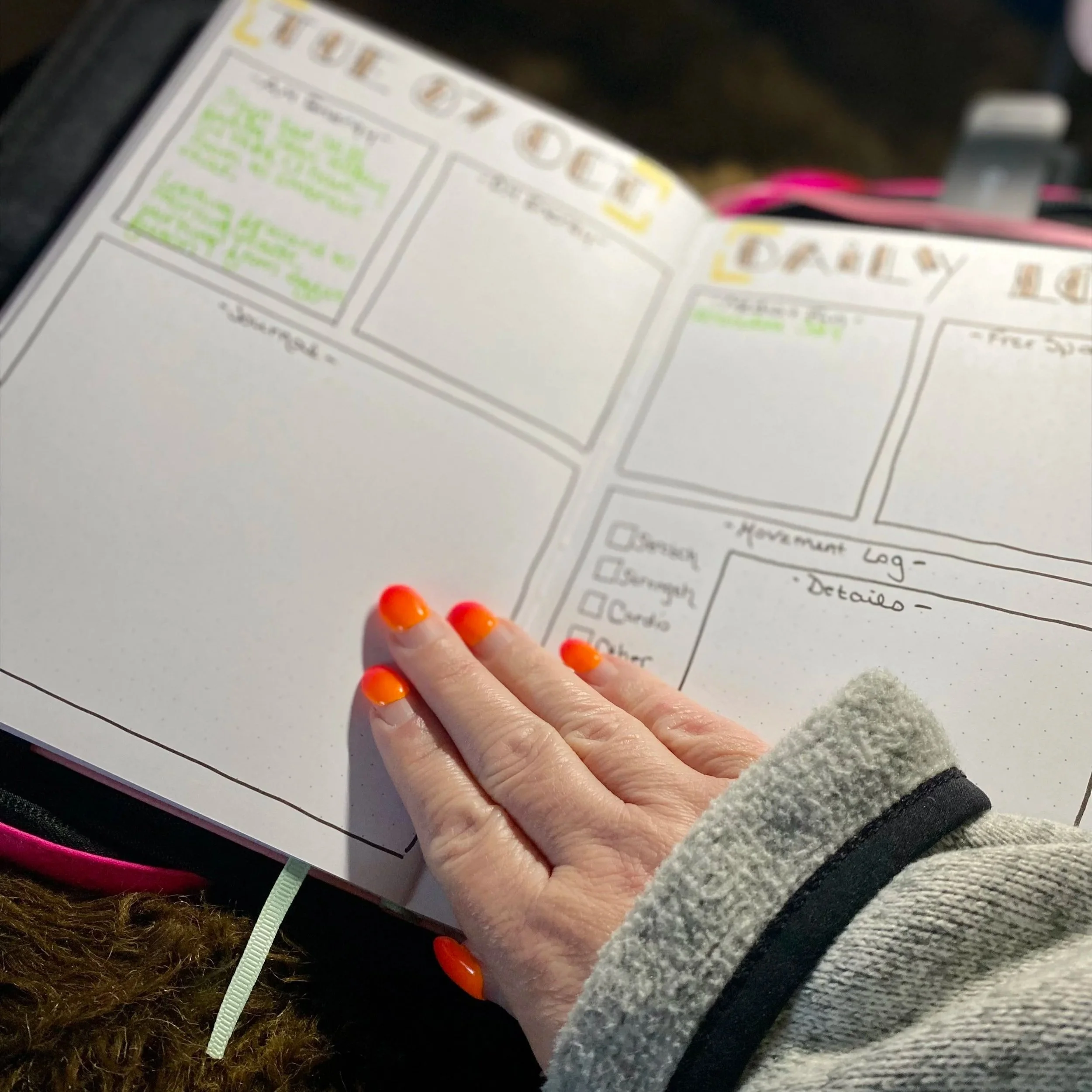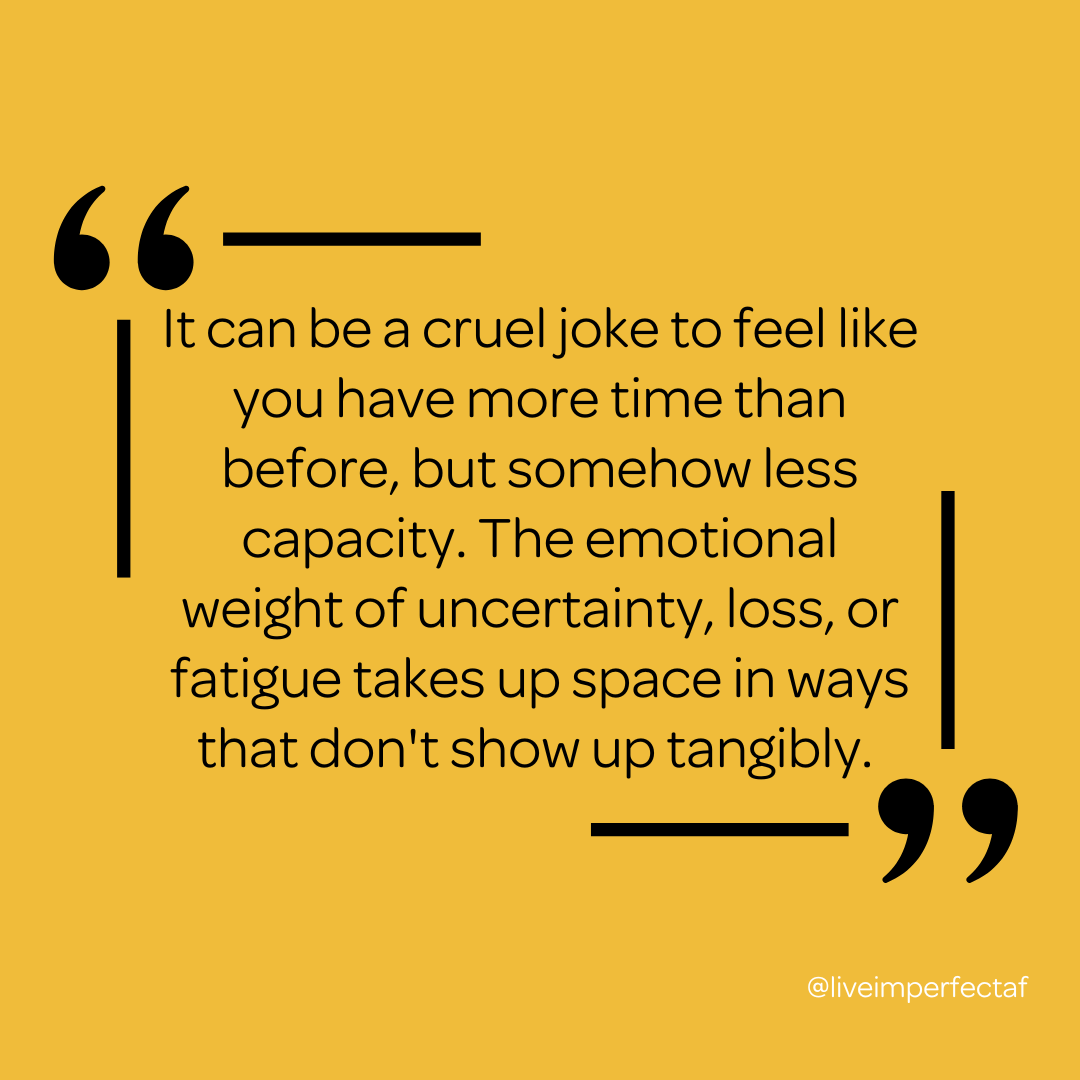A Holistic Wellness Coach's Personal Toolkit for Life Transitions: Part 2 - creating space
Laying it all out. Sometimes the chaos needs to leave your body and land somewhere you can see it.
Last week, I shared the internal foundation for navigating life changes: acknowledging what's real, laying it all out, and giving myself timeline reality checks.
Those practices create clarity, it takes more than clarity to get me through the hard days. I also need the doing—what I actually do with my body, time, and energy. This week I'm sharing three actions that help me create actual space.
The last few years have brought waves of significant change. Some I consciously chose and some chose me. My capacity has been stretched. I’ve had to be really intentional about what gets my energy. Occasionally I joke that I'm a pawn in someone else's reality show—how can this much happen to one person? Some days I am able to leverage my self-love toolkit. Other days I forget entirely or simply ignore. Life is a daily practice for me.
Maybe you're here because you're navigating something similar. Maybe your transition looks different: burnout, grief, or job searching in a difficult market. Important changes don't always take up physical space. In fact, sometimes they actually create it. But they do consume just as much emotional and mental energy. The calendar might be emptier, but your head and heart become overloaded. Whatever your transition looks like, the approach in this series can provide help and support.
I believe wellness is composed of seven interconnected areas: physical, emotional, financial, intellectual, spiritual, environmental, and relational. Major life transitions ripple through all of them. For example, a chronic condition diagnosis may not only show up in our bodies (physical), but a also impact our job security (financial) or require medications and treatments that have side effects impacting our moods (emotional).
The actions I'm sharing this week help you create space across whatever areas your transition is touching.
Creating Space
Creating space isn't just about clearing your calendar, though that matters too. It's about making room for everything this transition requires: the tasks that need to be done, the emotional processing, the routine changes, and the energy drain you didn't see coming.
The following three actions help me do exactly that.
Externalize What’s going on Inside
Your body can hold a lot, but it was never meant to be a storage container for unexpressed emotions and unprocessed stress.
Holding emotions inside can show up in ways we don't always connect to something occurring in our lives: digestive distress, exhaustion, being short-tempered, headaches, and difficulty focusing. When we ask our bodies to carry more than they should, something will eventually give. Something has to spill over.
It’s pretty accepted in society to externalize positive emotions, such as celebrating a milestone, showing love for a friend, or applauding a performer you enjoy. But any emotion can be processed externally.
Externalizing emotions is a way to help bring your body back toward either a calm, natural state as well as let go of feelings that are doing more harm than help. While some emotions are useful in processing, others become walls that can prevent us from moving forward through situations we can't control, and can have negative impacts on our bodies.
Similar to positive emotions, what the release of negative ones looks like can vary. Sometimes what needs to come out wants a gentle expression like journaling, meditation, or talking it through with someone you trust. Other times, these emotions need a physical release like going for a run or maybe even taking it out on a sourdough starter. Even breaking something (safely of course and preferably with something you don't need or have permission to use) can provide the cathartic release your body is craving.
Research has shown that free expression of emotion provides clear and sustainable benefits for physical and mental health and general wellbeing.
Personally, I leverage a variety of these depending on what the emotion needs in the moment. Sometimes I need to anxiety text a friend. Other times getting some type of exercise in aids processing. And sometimes it’s screaming — not at someone else, but into the void (or a pillow). The method isn’t as important as the release—getting it OUT instead of holding it IN, in a safe way.
What this looks like in practice:
Calling someone who will simply listen as you vent and not go directly to solutions
Moving your body: dancing, shaking it out, stretching
Creative expression: drawing, writing, making music
Physical release: screaming in your car, punching a pillow
Occasionally, I facilitate virtual scream rooms, which are safe spaces where others can release what they're holding through various practices that can be done from home. Sometimes it can be helpful to know there are others who are also in the midst of it or have that space offered and made available to you. The next one isn't on the calendar yet, but subscribe to my newsletter for updates.
Recognize the Space Change Takes and Actually Create It
I’m just gonna say it: big life changes are invisible energy vampires.
They drain your capacity without you noticing. You might wonder why you can't focus on simple tasks, why your body feels more fatigued than usual, or why everything feels harder than it should. A 2024 study revealed that cognitive fatigue can result in choosing easier, lower-reward options over harder, beneficial ones. This explains why you might have free time but can't bring yourself to do anything with it.
Some of these vampires are sneaky. Things like job uncertainty, grief, and burnout don't block appointments on your calendar. It can be a cruel joke to feel like you have more time than before, but somehow less capacity. The emotional weight of uncertainty, loss, or fatigue takes up space in ways that don't show up tangibly. An empty calendar doesn't mean you have energy to fill it.
The first step is recognizing how much space this change is actually taking in various areas of your wellness, such as physically, emotionally, or even financially. The second step is deliberately creating space for it.
Humans have a limited capacity each day—we're not that different from our phone low battery warnings. Creating space means accepting what you can't control and choosing to act on what you can instead. Creating space means making room. Real, tangible room.
In a very concrete way, making space can involve re-evaluating activities and deciding where it’s helpful to make room for the physical activities this change requires. But the way this situation impacts our emotions and energy also matters and it's important to also hold space for those emotions and feelings.
When I need to create space, I use three criteria: What can be simplified? What can be outsourced? What can be eliminated?
What this looks like in practice:
What can be simplified? Lower your standards or the time a task takes temporarily
What can be outsourced? Delegate tasks, hire help if it’s a financially viable option
What can be eliminated? Skip obligations that aren't essential right now
These three questions help me make informed decisions about where my energy goes. Not forever. Just for now. Protecting my energy is always important to me, but it becomes essential in these heavier situations.
Protect Your Energy Ruthlessly
During transitions, when you're already stretched thin, who you spend time with and what you watch, read, or consume, becomes more meaningful.
Not every person, conversation, or piece of content serves you right now. Some fill you up. Some drain you. And when your reserves are already low, you can't afford to ignore the difference. This protection can help with the space creation mentioned above.
I've implemented "Do Not Disturb Fridays.” Outside of work or appointments I cannot schedule any other time, I try to make my work day as light as possible, and DO NOT commit to any extracurricular events, professional or social. Instead I allow complete flexibility based on how my energy is at the end of the week. Sometimes that means a walk. Sometimes it means chilling on the sofa watching Gilmore Girls in pajamas that don’t match. And occasionally I still have enough bandwidth and desire for social interactions. The point isn't what I do, but rather that I've protected that time to do whatever my whole body needs in the moment.
What this looks like in practice:
Saying no, setting boundaries, prioritizing yourself
Limiting social media and doomscrolling
Choosing what you share and with whom. Not everyone needs the full story
Moving that non-critical meeting to another day
This kind of ruthless energy protection might feel uncomfortable, even selfish, at first. It might even go against everything you’ve been taught about being available, helpful, and accommodating. But during major transitions, your energy is the most precious resource you have. Guard it accordingly.
Pause and Reflect
Before you continue, sit with these questions:
What's draining your energy right now that you could release?
Who or what do you need to protect yourself from during this transition?
What would it look like to be more "selfish" with your time and energy?
Grab your journal or just sit with these for a moment.
Sometimes emotions need a physical release. This is one of mine.
The Work Continues
These three actions—externalizing, creating space, and protecting energy—help me move through my days. Some days I practice them well. Some days I forget completely or my emotions take over. But I always notice a difference when I leverage them.
Next week, I'm sharing the final piece: the reality check, which is the stuff we don't always talk about. When our toolkits aren't enough, celebrating where we can, and learning to find comfort in the process even when the end point is unknown.
Until then, I'm curious: Which of these three actions feels most challenging for you right now? Or which one do you most need permission to do? Drop a comment or send me a message—I'd love to hear where you are.
Ready to navigate your life transition with support instead of struggling through alone? I'd love to help you move through what you're facing with tools that actually fit your life. Because when you have someone holding space for both your struggle and your strength, the path forward becomes clearer.




